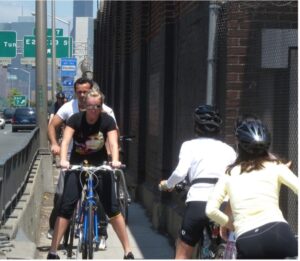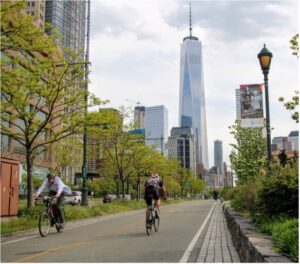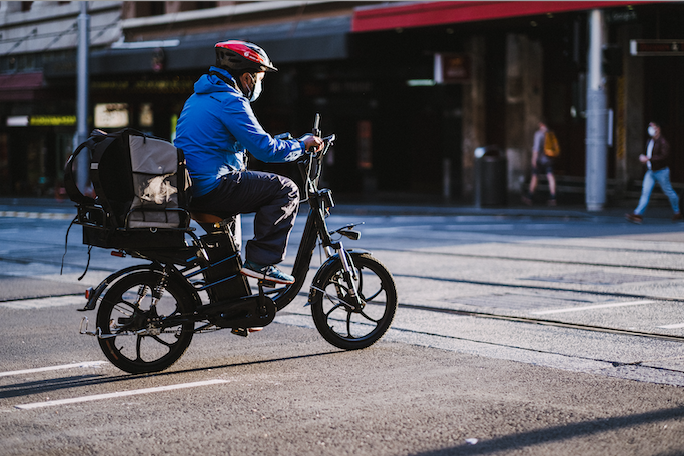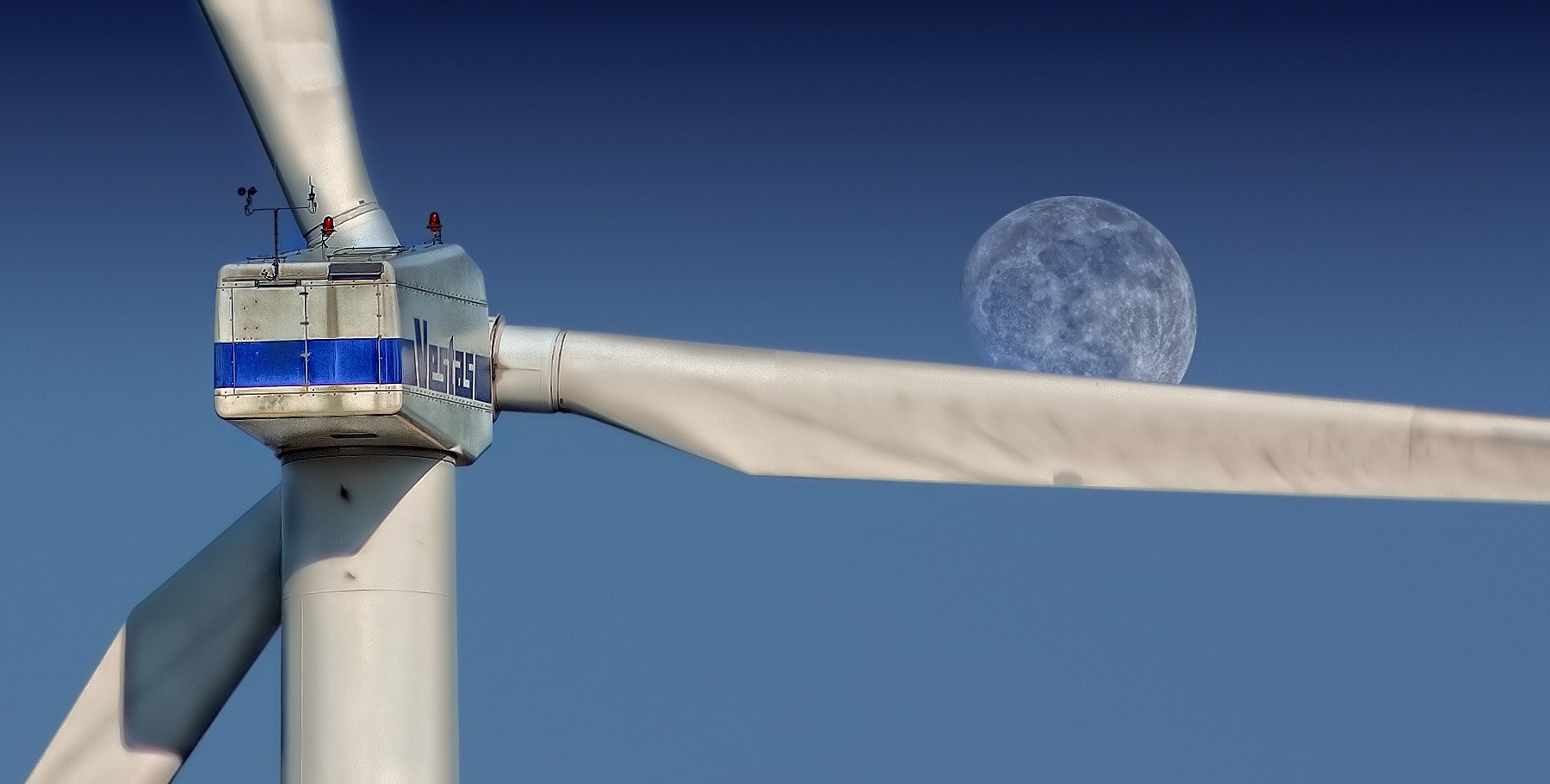By William C. Rose, Managing Editor at N.Y.U. Environmental Law Journal
This post is part of the Environmental Law Review Syndicate.
Introduction
E-bikes[1] were legalized across New York State in April 2020 following a period of unintentional illegality that spawned punitive enforcement measures against the food delivery riders who rely on e-bikes in New York City. In the course of legalizing the bikes, however, the legislature created a special carve-out for the Hudson River Greenway (“the Greenway”)—a major bike path on the west side of Manhattan—banning e-bikes from what is likely the safest north-south route on the island. The ban raises serious equity issues, lacks any rationale beyond use preferences, and is poor public policy for a city attempting to move to a post-car future.
In its first Section, this Article provides an overview of the Greenway and its importance to cycling in New York City, a description of e-bikes and delivery riders, and summarizes the tumultuous history of e-bikes in the city. In Section II, this Article elaborates on the current e-bike ban on the Greenway, the threats posed by its enforcement, the lack of a public safety rationale for it, and the poor public policy it represents. Though enforcement has yet to begin in earnest, this Article concludes that the ban should have no place in the future of New York.
I. Background
A. The Hudson River Greenway in Manhattan
The Hudson River Greenway stretches along the west side of Manhattan, from Battery Park in the south to Fort Tryon park in the north, covering a distance of approximately thirteen miles and essentially the length of the island.[2] True to its name, the Greenway is on or very close to the Hudson River for the entirety of its run, and it enjoys a reputation as the busiest bike path in North America.[3] The path is mixed-use: designed for biking, in-line skating, running, and walking, though its busy southern stretch—from roughly 59th Street to the Battery—sees pedestrians directed to fully-separated walking paths in adjacent Hudson River Park.
The Greenway’s management structure is complex. South of 59th Street, the path is owned by the state as part of Route 9-A, while to the north it is generally owned by New York City. The Greenway is maintained and regulated by New York City’s Department of Transportation or Department of Parks and Recreation, depending on location, with Hudson River Park (a state public benefit corporation) assisting with maintenance south of 59th Street.[4] The New York City Police Department is primarily responsible for law enforcement on the Greenway, though the city’s Parks Enforcement Patrol shares responsibility, particularly on sections north of 59th Street, where the Greenway is entirely within park lands.
To the cyclist, however, the Greenway is simple. It is an unbroken green line on the bike map[5]—a rarity in the city—providing safe, car-free north-south travel along the west side of Manhattan. It is the only such route in New York, with no other cycleway able to compare the Greenway’s length and safety. It is prized by recreational cyclists as a scenic ride, by commuters as a safe route, and by delivery riders as a crucial artery allowing fast and safe travel along the west side.[6] The Greenway is in many senses an ideal: a car-free route for a city designed around people, rather than a stretch of painted asphalt on the fringe of a vehicular thoroughfare.
Delivery riders describe the Greenway as “essential” for their work.[7] Workers’ advocates, similarly, describe the Greenway as a way “workers have been able to deliver food from one neighborhood to another one, travel safely and not go through high traffic or dangerous streets.”[8] With twenty-six cyclists having been killed on New York City streets in 2020,[9] and twenty-eight in 2019,[10] the Greenway is more than a mere convenience. It is a safe haven from the many threats cyclists in New York face—the car door that opens unexpectedly, the Uber driver swerving to drop off a fare, the box truck running a red—any one of which could bring a violent and painful death.
B. E-bikes and Delivery Riders
E-bikes have been hailed as a revolutionary development in low-carbon urban transportation, allowing riders to travel significant distances even if age, fitness level, or simple preference to avoid sweating would prevent them from doing so on a conventional bike.[11] New York State employs a tripartite classification scheme for e-bikes, ranging from Class One pedal-assist e-bikes, like those offered by Citi Bike (New York City’s bikeshare operator), to Class Three e-bikes with independent throttles and maximum speeds of twenty-five miles per hour.[12]
According to a 2012 estimate by the city Department of Transportation, there are over fifty thousand delivery cyclists in New York City,[13] and the ever-booming app-based takeout economy has likely led to a significant increase since that study.[14] The job is not an easy one, nor a prestigious one, as the former Village Voice’s Stephen Miller describes:
Delivering meals by bicycle is the type of work that constantly reminds the people who do it that they are squarely at the bottom of New York City’s food chain. Hustling for tips in heat, rain, snow and cold, looked down upon by doormen, despised by pedestrians, these workers, often undocumented immigrants from China or Latin America, are ubiquitous in New York’s streets yet all but voiceless in its power structure.[15]
Delivery riders now mostly work for app services that facilitate transactions between restaurants and consumers, chiefly Grubhub (also doing business as Seamless), which controls roughly 85 percent of the food delivery market in New York City.[16] These “gig economy” workers are treated as private contractors and paid per job, rather than given an hourly wage by the restaurant(s) for which they deliver.[17] Comprehensive data on delivery workers’ hours and wages is nonexistent, though Gothamist (a local news site and part of WNYC, New York’s public radio) reported one rider as having ridden, in ten hours on a single day, sixty miles over the course of thirty-four deliveries, earning “little more than $80” in the process.[18]
 Figure 1: A row of Arrow e-bikes, impounded at an NYPD precinct. NYPD 72nd Precinct (@NYPD72ndPct), Twitter (Oct. 6, 2017), https://twitter.com/NYPD72Pct/status/916480629767917569?s=20.
Figure 1: A row of Arrow e-bikes, impounded at an NYPD precinct. NYPD 72nd Precinct (@NYPD72ndPct), Twitter (Oct. 6, 2017), https://twitter.com/NYPD72Pct/status/916480629767917569?s=20.
Arrow e-bikes—a ubiquitous sight on New York City streets—are Class Three e-bikes under state law and are widely relied upon for the much-maligned job of food delivery.[19] Many delivery riders consider e-bikes like the Arrow essential to their job. For some, the bikes are a way to deliver food quickly, avoiding complaints and inviting tips while increasing the number of deliveries they can make—and get paid for—in a day.[20] For others, especially older workers for whom the bodily stress of long days on the road is a distinct struggle, the bikes are a lifeline that enables them to do their jobs.[21]
C. The History of E-bikes in New York City
Prior to April 2020, e-bikes were illegal in New York State due to a gap in the state’s laws. E-bikes were considered motor vehicles, but could not be registered with the Department of Motor Vehicles, and were thus treated as “unlicensed motorcycles.”[22] New York City formally—and redundantly—banned e-bikes in 2013 by act of the city council, responding to unfounded beliefs that the bikes posed a danger to pedestrians,[23] though enforcement was lax during the final days of the Bloomberg administration.[24] Council members representing wealthy neighborhoods—particularly the Upper East Side—drove continued efforts against e-bikes.[25]
Mayor de Blasio, beginning his first term in 2014, gradually escalated enforcement against e-bikers, with ticketing targeted at delivery riders. In 2017, responding to continued complaints from wealthy, white neighborhoods in Manhattan, Mayor de Blasio announced a large-scale crackdown on e-bike riders despite admitting that no accident, injury, or fatality data supported the proposition that e-bikes posed a danger to pedestrians.[26] Despite the mayor’s rhetoric fixing blame for the e-bike “problem” on restaurant owners, this “war on e-bikes” was targeted squarely at delivery riders and placed significant financial and legal burdens on a largely-immigrant population of workers.[27] In 2019, for example, the NYPD issued 1,052 summonses (each carrying a $500 fine) against e-bike riders and confiscated 1,575 e-bikes, while only seventy-one summonses were issued to businesses for the e-bike-related infractions of riders carrying their food.[28]
The city’s Department of Transportation legalized pedal-assist e-bikes via rule changes in 2018,[29] clearing the way for Citi Bike’s e-bikes, though doing nothing for delivery riders.[30] Advocates, led by State Senator Jessica Ramos of Queens, began pushing to legalize all e-bikes statewide during this time, passing a bill doing so in 2019 only for it to fall to Governor Andrew Cuomo’s veto.[31] Delivery riders would only receive relief from Mayor de Blasio’s crackdown after the COVID-19 pandemic had taken hold of the city, foregrounding the much-maligned riders as essential workers and prompting the mayor to suspend enforcement in March 2020.[32]
Finally, as part of the New York State Fiscal Year 2021 Budget Agreement, enacted in April 2020, e-bikes were legalized across the state.[33] These e-bike provisions were essentially identical to those of the 2019 bill,[34] and they created the tripartite classifications scheme discussed above.[35] In the same act, however, the legislature banned e-bikes from the Hudson River Greenway and reserved power to regulate e-bikes on the Greenway for itself, promising a continuation of Mayor de Blasio’s “war on e-bikes.”
II. A Problematic E-bike Ban on the Greenway
E-bikes are currently banned on the Hudson River Greenway, an anomalous and ill-publicized restriction on New York City’s bike paths, with significant penalties for violations despite the lack of any public safety rationale behind the ban. Even setting aside the racial and class inequities represented by the ban, it represents poor public policy for a city attempting to decarbonize transportation and reduce reliance on cars.
A. The Ban
New York State law now allows e-bikes to use all public “highways,” broadly defined to include essentially all streets,[36] but prohibits them on “any greenway running adjacent to or connected with a highway,” specifically including the Hudson River Greenway.[37] This ban extends to all three classes of e-bikes, without distinction.[38] The law further allows state agencies and local governments to regulate e-bike use within their jurisdiction, but it exempts the Greenway from this delegation.[39] Shortly after the state legalized e-bikes, the city council legalized them across the five boroughs—categorizing e-bikes as bicycles, subject to the same rights and responsibilities as conventional bikes.[40] The end result of this legislative activity is that e-bikes are legal across New York State, on every public road, and are legal across New York City, free to be used wherever conventional bicycles are used, except on the city’s busiest bike path.
The Greenway e-bike ban is anomalous and almost entirely unpublicized. Nowhere else in the city are e-bikes banned from a path which conventional bikes may use. The city’s official bike map offers no warning of the ban, despite explaining other laws unique to e-bikes and confusingly asserting that e-bikes are permitted in “the bike lanes,” a term which in both common usage and in the parlance of the bike map includes the Greenway.[41] Neither the city’s “Official Cycling Guide” nor its compilation of cycling laws references e-bikes on the Greenway, though neither appears to have been updated since e-bikes were legalized.[42] Neither Citi Bike’s page advertising its e-bikes nor its page suggesting the Greenway as “one of the most popular places to ride” warns its customers that riding its e-bikes on the Greenway is a violation of state law,[43] though Citi Bike is aware of the illegality and advocated against the ban in 2019.[44] It is likely that the only way a cyclist could become aware of the ban, short of being stopped and ticketed, is through recently-erected signs along the Greenway indicating—in English only—“No Motor Vehicles/E-bikes/E-Scooters.”[45]
B. Threats of Enforcement
E-bikers face substantial fines and even imprisonment for riding on the Greenway. Though penalties for certain e-bike offenses, such as failure to yield to a pedestrian, were fixed at $50 fines in the legalizing statute,[46] riding on the Greenway is an infraction covered by the Vehicle and Traffic law’s general penalty provisions.[47] A first offense can carry a penalty of up to $150 and fifteen days in jail, with punishments escalating to a maximum of $450 and ninety days in jail for third and subsequent offenses within an eighteen month period.[48] Such penalties are significant for any cyclist, though for delivery riders they are potentially ruinous. Full-time riders have reported to the Times making roughly $100 on a good day of work, with others earning as little as $32 for six and a half hours’ work.[49] A fine for a first offense would more than wipe out a good day’s earnings, while the maximum of $450 could easily eliminate a full week’s wages.
These penalties have yet to be levied in any significant numbers, and no plan for enforcement has been publicly discussed, though there appears to be a slow progression towards active ticketing. Hudson River Park Trust’s Advisory Council began calling for enforcement only months after the law took effect, with members specifically calling for NYPD involvement.[50] The signage referenced above—reading “No Motor Vehicles/E-bikes/E-Scooters”—was installed in March 2021.[51] City Hall, during both the de Blasio administration and the recently-inaugurated administration of Eric Adams, has remained silent on the issue.[52] Police enforcement of the ban began in a minor fashion in November 2021. For two days early in the month, and without any warning, an NYPD SUV parked blocking roughly half the Greenway at around 91st Street, and officers were seen stopping and ticketing delivery cyclists, but no other e-bikers.[53] Information on the number and character of the tickets issued is not available, and there have been no subsequent statements from NYPD or any other organ of government regarding the November campaign.[54]
The future for enforcement is unclear, but troubling. Mayor Adams has not taken a public stance on e-bikes or the Greenway, adding another element to the “mystery” of what his New York will look like.[55] The mayor is known to support cycling in general,[56] but the only policy his administration has announced (to date) touching on traffic safety relies on increased NYPD enforcement against cyclists.[57] This is especially concerning given the NYPD’s significant racial bias in cycling enforcement, annually issuing about 75% of bike-related infractions to Black and Latinx New Yorkers—who together comprise less than half the city’s population.[58] Moreover, the history of e-bike enforcement in New York suggests that any further enforcement of the Greenway ban will be squarely targeted at delivery riders.[59]
C. The Ban Lacks any Rationale Beyond Use Preferences
Neither the 2020 e-bike legalizing provisions of the budget agreement nor their near-identical 2019 forebears made any statement of purpose regarding the ban, though a public safety justification can be discerned from statements of the ban’s few public supporters.[60] There is no legitimate public safety rationale for banning e-bikes on the Hudson River Greenway, however, nor any discernible rationale beyond use preferences.
By Mayor de Blasio’s own admission in the midst of his “war on e-bikes,” there was no data to support the claim that e-bikes posed a danger to pedestrians,[61] a fact that remains true today. E-bike users do not collide with other road users in any significant numbers, with only thirty-one e-bike-related collisions reported to the NYPD in 2018, for example, out of a total of 45,775 collisions by all types of vehicles in the city.[62] Of those thirty-one collisions, only nine resulted in injuries to pedestrians, and none resulted in pedestrian fatalities.[63] Drivers, by contrast, were responsible for over 10,000 pedestrian injuries and 121 pedestrian fatalities in the same year.[64] In Hudson River Park specifically, officials testifying in favor of the ban in mid-2019 admitted that only two e-bike-related crashes had occurred along the Greenway that year,[65] a remarkably low figure given the Greenway’s heavy use. Even if there were a connection between e-bikes and injuries, the spacious Hudson River Greenway, with its clear separation of pedestrians and cyclists south of 59th Street, is one of the better-suited bike paths in Manhattan for fast moving traffic, especially compared to the East River Greenway, on which e-bikes are permitted and which, at points, forces cyclists and pedestrians into very narrow confines.
 |
 |
Figures 3 and 4: On left, the tightest point of the East River Greenway, through which pedestrians, conventional cyclists, and e-bikers, all must fit. On right, a typical stretch of the Hudson River Greenway adjacent to Hudson River Park; pedestrians make use of a dedicated path behind the greenery on the right side of the photo. E-bikes are permitted on the path pictured on the left, but banned from the path pictured on the right. Manhattan Waterfront Greenway, Wikipedia, https://en.wikipedia.org/wiki/Manhattan_Waterfront_Greenway (last edited May 4, 2021); John Wachunas, New Year’s Cycling: 17 Bike Rides You Need To Experience in 2017, Spinlister, https://www.spinlister.com/blog/new-years-cycling-17-bike-rides-need-experience-2017/ (last visited May 10, 2021).
Lacking a public safety rationale, one strains to think of a justification for the e-bike ban other than use preferences. The question of whether the Hudson River Greenway should be available to commercial cyclists is a legitimate one touching on larger questions of what the cityscape of a New York defined by multi-modal transportation should look like. Commercial vehicles are banned from parkways in New York without serious controversy, and so, setting aside the implicit race- and class-based objections of e-bike opponents in New York City, perhaps the e-bike ban on the Greenway is simply the first of its kind—an exclusively recreational bikeway. But, given the current state of cycling in New York City, the ban represents poor public policy.
D. The Ban is Poor Public Policy
The e-bike ban on the Hudson River Greenway is poor public policy. It forecloses on safe cycling for e-bikers on Manhattan’s west side and may stifle the growth of low-carbon personal transportation at a time when the city is actively seeking to de-carbonize and de-car its streets.
By banning e-bikes on the Greenway, the state legislature has essentially foreclosed on the possibility of a safe, off-street north-south cycling route on the west side of Manhattan. The principle alternative to the Greenway as it currently exists is to remove the westernmost lane of Route 9-A (the Westside Highway) and either use the space to dramatically widen the Greenway or as a separate thoroughfare for fast moving traffic, options long suggested by transit advocates.[66] North of 59th Street, where Route 9-A becomes an elevated expressway, similar proposals have been offered to convert part of Riverside Drive into a dedicated cycleway. The state Department of Transportation, however, has consistently rejected any lane reduction for the Westside Highway,[67] and its city counterpart has similarly declined to entertain calls for such changes to Riverside Drive. By banning e-bikes on the Greenway, the state legislature has thus removed the only safe, off-street route available or likely to become available in the near future.
Barring a coastal route, north-south bound cyclists on the west side of Manhattan can only be served by the city’s on-street “protected” bike lanes on Eighth and Ninth Avenues. These avenues suffer from overcrowding, with narrow and heavily trafficked sidewalks near Penn Station and the Port Authority Bus Terminal, in particular, forcing pedestrians into the bike lane, in turn forcing cyclists into vehicle lanes, effectively negating the safety promises of the bike lanes.[68] Even ignoring this issue, these on-street routes expose cyclists to turning traffic, dooring, and frequent use of the lanes for temporary parking by police and delivery vehicles. The promise of the Greenway is in its car-free nature; barring a significant reimagining of the west side’s avenues, they will never suffice as a replacement.
One might argue that e-bikes, more capable than conventional bikes at keeping up with car traffic, should simply use streets instead. But this argument ignores the facts that, first, all e-bikes are banned from the Greenway, not just Class Three bikes capable of reaching the city’s twenty-five mile per hour speed limit for cars, and second, even at equivalent speed to cars, e-bike riders are still placed at significant risk when mixing with traffic. Drivers may have “fender benders” in midtown traffic without serious consequence; cyclists—even e-bikers—risk death for similar collisions, lacking the protection of a steel cage that drivers enjoy.
By banning e-bikes, the state legislature threatens to stifle the growth of low carbon personal transportation at a time when the city—and indeed much of the world—is seeking to promote exactly such technologies.[69] The ban only affects one route in the city, but it is, again, a crucial and visible route. Once enforcement begins, why would a would-be e-bike owner purchase a form of transport that has been uniquely singled out? Where else, a prospective owner might wonder, might one be ticketed for riding? The ban adds a level of uncertainty to a behavior the state should be encouraging, and distinctly marks a technology poised to make personal transit more accessible as officially undesirable. Similar uncertainty is introduced for the would-be Citi Biker, the “undock and go” convenience of the rental bikes undermined by an arbitrary ban on some of the bikes from the city’s busiest bike path.
Conclusion
The legalization of e-bikes in New York State represents a long-overdue legitimation of vital tools relied upon by low-income, immigrant delivery riders and a recognition of what may be the future of personal transportation. The concurrent ban on e-bikes on the Hudson River Greenway, however, threatens both to continue a “war on e-bikes” that imposes significant financial and legal burdens on a vulnerable population of New Yorkers and to stifle the growth of low-carbon personal transport in a city striving to meet the environmental challenges of the twenty-first century. Considerations of equity and the environment both weigh strongly against the e-bike ban, and the ban should be repealed, lest the Greenway stand in the way of a greener New York.
[1] This paper will use the term “e-bikes” to refer to all bicycles featuring both an electric motor and conventional human propulsion. Legal distinctions between e-bikes will be discussed as relevant.
[2] See, e.g., City of New York, Manhattan Waterfront Greenway Map (2003), http://www.nyc.gov/html/edc/pdf/greenway_mapside.pdf.
[3] E.g., Gersh Kuntzman, Public Nervous Announcement: Busiest Bike Path in North America to the Severed for Weeks, Streetsblog NYC (Sept. 22, 2020), https://nyc.streetsblog.org/2020/09/22/public-service-announcement-busiest-bike-path-in-north-america-to-be-severed-for-months/ (describing the Greenway as “the continent’s busiest bike path”).
[4] E.g., Dave Colon, Stop Ruining the Hudson River Greenway in the Name of Security, Streetsblog NYC (Nov. 3, 2017), https://nyc.streetsblog.org/2017/11/03/stop-ruining-the-west-side-greenway-in-the-name-of-safety/ (“The segment of the greenway below 59th Street is owned by the state, but operated and maintained by the Hudson River Park Trust.”); Dave Colon, ‘Progressive’ Manhattanites Push For Cop Crackdown On E-Bike Riders (Again), Streetsblog NYC (Sept. 16, 2020), https://nyc.streetsblog.org/2020/09/16/progressive-manhattanites-push-for-cop-crackdown-on-e-bike-riders-again/ (describing the “confusing mishmash of bureaucracies” responsible for the Greenway).
[5] See City of New York, NYC Bike Map 2021 (2021), https://www1.nyc.gov/html/dot/downloads/pdf/nyc-bike-map-2021.pdf.
[6] See Dave Colon, City Hall Remains Silent As Hudson River Greenway E-Bike Ban Continues, Streetsblog NYC (Mar. 15, 2021), https://nyc.streetsblog.org/2021/03/15/city-hall-remains-silent-as-hudson-river-greenway-e-bike-ban-continues/.
[7] Colon, supra note 6.
[8] Id.
[9] See Julianne Cuba, POST-MORTEM: Cyclist Victims Killed In 2020 Were Low-Income, Essential Workers, Streetsblog NYC (Jan. 22, 2021), https://nyc.streetsblog.org/2021/01/22/post-mortem-cyclist-victims-killed-in-2020-were-low-income-essential-workers/.
[10] See Emma G. Fitzsimmons, More Pedestrians and Cyclists are Dying in N.Y.C. Drivers are Often to Blame, N.Y. Times (Mar. 10, 2020), https://www.nytimes.com/2020/03/10/nyregion/nyc-deaths-pedestrian-cycling.html.
[11] See, e.g., Lloyd Alter, 3 Things Are Needed for the E-Bike Revolution, Treehugger (Sept. 29, 2019), https://www.treehugger.com/things-are-needed-e-bike-revolution-4855098 (describing needed infrastructure changes to enable the “e-bike revolution”).
[12] N.Y. Veh. & Traf. Law § 102-c (Consol. 2021).
[13] See Stephen Miller, NYC Delivery Cyclists Speak Out About The Toughest Job On Two Wheels, Village Voice (Mar. 23, 2017), https://www.villagevoice.com/2017/03/23/nyc-delivery-cyclists-speak-out-about-the-toughest-job-on-two-wheels/.
[14] See, e.g., Levi Sumagaysay, The pandemic has more than doubled food-delivery apps’ business. Now what?, Market Watch (Nov. 27, 2020), https://www.marketwatch.com/story/the-pandemic-has-more-than-doubled-americans-use-of-food-delivery-apps-but-that-doesnt-mean-the-companies-are-making-money-11606340169 (describing the pandemic-related boom in the app-based food delivery market).
[15] Miller, supra note 13.
[16] See Christopher Robbins & Jeffrey E. Singer, NYC’s War On E-Bikes Takes Toll On Immigrant Delivery Workers, Gothamist (Apr. 26, 2018), https://gothamist.com/news/nycs-war-on-e-bikes-takes-toll-on-immigrant-delivery-workers.
[17] See, e.g., Tanay Warekar, NYC Food Delivery Worker’s Death Amplifies Concerns For Gig Employees, Eater (Apr. 2, 2021), https://ny.eater.com/2021/4/2/22364128/manhattan-delivery-worker-death-third-party-app-doordash.
[18] Robbins & Singer, supra note 16.
[19] See Dave Colon, Justice Delivered: E-Bikes Legalized Statewide In Budget Bill, Streetsblog NYC (Apr. 1, 2020), https://nyc.streetsblog.org/2020/04/01/justice-delivered-e-bikes-legalized-statewide-in-budget-bill/.
[20] See Robbins & Singer, supra note 16 (“In dozens of interviews, delivery cyclists told Gothamist that e-bikes were essential to their jobs….”).
[21] Miller, supra note 13 (“Older delivery cyclists, in particular, rely on e-bikes because they reduce stress on the body and help them reach the far corners of a restaurant’s delivery zone, making them more appealing to hire.”).
[22] E.g., Brad Aaron, Why Are Electric Bikes Illegal, Anyway?, Streetsblog NYC (Apr. 10, 2013), https://nyc.streetsblog.org/2013/04/10/why-are-electric-bikes-illegal-anyway/.
[23] See discussion infra Section II.C.
[24] See Scott Heins, Is The E-Bike Ban Even Being Enforced?, Gothamist (Dec. 6, 2013), https://gothamist.com/news/is-the-e-bike-ban-even-being-enforced.
[25] See Colon, supra note 19.
[26] See, e.g., David Meyer, De Blasio and NYPD Should Talk to Delivery Workers About E-Bikes, Streetsblog NYC (Oct. 20, 2017), https://nyc.streetsblog.org/2017/10/20/de-blasio-and-nypd-should-talk-to-delivery-workers-about-e-bikes/.
[27] See Robbins & Singer, supra note 16.
[28] Christopher Robbins, De Blasio’s E-Bike Crackdown Mainly Hurts Delivery Workers, Not Employers, Gothamist (Jan. 24, 2020), https://gothamist.com/news/de-blasios-e-bike-crackdown-mainly-hurts-delivery-workers-not-employers.
[29] See, e.g., Press Release, Office of the Mayor, Mayor de Blasio Announces New Framework to Clarify Legality of Pedal-Assist Bicycles (Apr. 3, 2018), https://www1.nyc.gov/office-of-the-mayor/news/165-18/mayor-de-blasio-new-framework-clarify-legality-pedal-assist-bicycles.
[30] See, e.g., Robbins & Singer, supra note 16.
[31] See Senate Bill S5294A, N.Y. State Senate, https://www.nysenate.gov/legislation/bills/2019/s5294/amendment/a (last visited May 10, 2021); Bernadette Hogan, David Meyer, and Aaron Feis, E-bike, e-scooter bill stuck in Albany Cuomo’s spat with sponsor, N.Y. Post (Dec. 8, 2019), https://nypost.com/2019/12/08/e-bike-e-scooter-bill-stuck-in-albany-cuomos-spat-with-sponsor/.
[32] See Jake Offenhartz, De Blasio Pauses Crackdown On E-Bikes, As Delivery Cyclists Become ‘Frontline Workers’ In Coronavirus Crisis, Gothamist (Mar. 16, 2020), https://gothamist.com/news/de-blasio-pauses-crackdown-e-bikes-covid-19.
[33] S. 7508/A. 9508, Part XX, 2019–20 Reg. Sess. (N.Y. 2020).
[34] The major additions to the 2020 version were a helmet requirement for minors riding Class One and Class Two e-bikes, and for anyone riding a Class Three e-bike, as well as a specific criminalization of riding e-bikes when intoxicated. See Dave Colon, supra note 19.
[35] See N.Y. Veh. & Traf. Law § 1242 (Consol. 2021).
[36] See id. § 118.
[37] Id. § 1242(4)(a). This provision also extends the ban to the Niagara River Greenway, and may affect portions of the Hudson River Valley Greenway north of New York City. Id.
[38] See id.
[39] Id. § 1242(4)(b).
[40] See N.Y.C. Local Law No. 73 of 2020, § 2.
[41] See City of New York, supra note 5.
[42] See City of New York, Bike Smart: The Official Guide to Cycling in NYC, http://www.nyc.gov/html/dot/downloads/pdf/dot_bikesmart_brochure.pdf; N.Y.C. Dep’t of Transp., SUMMARY LISTING OF BICYCLE LAWS, RULES & REGULATIONS, https://www1.nyc.gov/html/dot/downloads/pdf/bicyclerules-english.pdf.
[43] See Meet the Citi Bike ebike, Citi Bike, https://www.citibikenyc.com/how-it-works/electric (last visited May 10, 2021); Hudson River Greenway, Citi Bike, https://www.citibikenyc.com/rides/hudson-river-greenway (last visited May 10, 2021), https://www.citibikenyc.com/rides/hudson-river-greenway.
[44] Gersh Kuntzman, Hey, West Side Greenway, Citi Bike Called and It Wants Its Bike Lane Back!, Streetsblog NYC (June 18, 2019), https://nyc.streetsblog.org/2019/06/18/hey-west-side-greenway-citi-bike-called-and-it-wants-its-bike-lane-back/.
[45] See Colon, supra note 6 (describing the signs and their having been installed in March 2021).
[46] N.Y. Veh. & Traf. Law § 1242(12) (Consol. 2021).
[47] See id. § 1800.
[48] Id.
[49] Kimiko de Freytas-Tamura, Food Delivery Apps Are Booming. Their Workers Are Often Struggling, N.Y. Times (Nov. 30, 2020), https://www.nytimes.com/2020/11/30/nyregion/bike-delivery-workers-covid-pandemic.html.
[50] See Colon, supra note 4.
[51] See Colon, supra note 6 (describing the signs and their having been installed in March 2021).
[52] See id.
[53] See Mark Gorton (@MarkGortonNYC), Twitter (Nov. 5, 2021), https://twitter.com/MarkGortonNYC/status/1456721613521629187?ref_src=twsrc%5Etfw%7Ctwcamp%5Etweetembed%7Ctwterm%5E1456721613521629187%7Ctwgr%5E%7Ctwcon%5Es1_&ref_url=https%3A%2F%2Fnyc.streetsblog.org%2F2021%2F11%2F12%2Fthe-parks-departments-e-bike-policy-is-not-consistent-with-state-law%2F (describing and providing photos of NYPD ticketing activity on the Greenway); Mark Gorton (@MarkGortonNYC), Twitter (Nov. 6, 2021), https://twitter.com/MarkGortonNYC/status/1457080465375039502?s=20&t=K6IZNnlhinNM-c1HILC9-g (“The cops are back again today. Blocking the bike path with their SUV. Pedestrians forced into conflicts with bikes.”).
[54] The NYPD’s 24th Precinct did, however, tweet about its officers “providing bicycle safety tips and enforcing bicycle rules” along the Greenway on November 5; the precinct’s photos fail to show any cyclists being stopped, and the tweet makes no mention of ticketing (nor of the officers’ choice to block the Greenway with their SUV). NYPD 24th Precinct (@NYPD24Pct), Twitter (Nov. 5, 2021), https://twitter.com/NYPD24Pct/status/1456749458436366336.
[55] Matt Flegenheimer, Michael Rothfeld, & Jeffery C. Mays, What Kind of Mayor Might Eric Adams Be? No One Seems to Know, N.Y. Times (Oct. 23, 2021), https://www.nytimes.com/2021/10/23/nyregion/eric-adams-mayor-nyc.html.
[56] See, e.g., Sam Raskin, Eric Adams bikes to work on second day in office, N.Y. Post (Jan. 2, 2022), https://nypost.com/2022/01/02/nyc-mayor-eric-adams-bikes-to-work-on-second-day-in-office/.
[57] See Tirhakah Love, The Mayor Is… Mayoring!?!?, Intelligencer (Jan. 19, 2022), https://nymag.com/intelligencer/2022/01/eric-adams-confronts-new-york-city-pedestrian-deaths.html (discussing Mayor Adams’s plan to “double down on enforcement” of certain cycling violations).
[58] See Julianne Cuba, NYPD’s Racial Bias in Ticketing Cyclists Continued Last Year, Streetsblog NYC (Jan. 4, 2022), https://nyc.streetsblog.org/2022/01/04/nypds-racial-bias-in-ticketing-cyclists-continued-last-year/.
[59] See discussion supra Section I.C.
[60] See, e.g., Gersh Kuntzman, Virtually No One Can Understand ‘Fairest City’ Mayor de Blasio’s Crackdown on E-Bikes, Streetsblog NYC (June 7, 2019) (quoting Connie Fishman, executive director of Hudson River Park Friends, as arguing that e-bikes on the Greenway would be dangerous for park visitors).
[61] E.g., David Meyer & Julia Marsh, De Blasio says ‘common sense,’ not data, justifies e-bike crackdown, N.Y. Post (Jan. 6, 2020), https://nypost.com/2020/01/06/de-blasio-says-common-sense-not-data-justifies-e-bike-crackdown/.
[62] Julianne Cuba, Damn Lies and Statistics: The Numbers Don’t Back Up de Blasio’s Reason for E-Bike Crackdown, Streetsblog NYC (Apr. 18, 2019), https://nyc.streetsblog.org/2019/04/18/damn-lies-and-statistics-the-numbers-dont-back-up-de-blasios-reason-for-e-bike-crackdown/.
[63] Id.
[64] See id.
[65] Kuntzman, supra note 60.
[66] See, e.g., Dave Colon, West Village To Cuomo: Take a Lane Away from Drivers on the West Side Highway, Streetsblog NYC (May 27, 2020), https://nyc.streetsblog.org/2020/05/27/village-board-to-cuomo-take-a-lane-away-from-drivers-on-the-west-side-highway/ (discussing recent incarnation of the West Side Highway proposal); Kuntzman, supra note 3 (discussing recent incarnation of the Riverside Drive proposal).
[67] See Dave Colon, State DOT Throws Cold Water on West Side Highway Bike Lane, Streetsblog NYC (Sept. 10, 2020), https://nyc.streetsblog.org/2020/09/10/state-dot-throws-cold-water-on-west-side-highway-bike-lane/.
[68] See, e.g., Cody Lyon, The Chaos on the Eighth Ave. Bike Lane, HuffPost (Jan. 19, 2016), https://www.huffpost.com/entry/the-chaos-on-the-eighth-a_b_9012382.
[69] E.g., Emma G. Fitzsimmons & Winnie Hu, Car Lanes to Become Bike Lanes on 2 Major New York City Bridges, N.Y. Times (Jan. 28, 2021), https://www.nytimes.com/2021/01/28/nyregion/bike-brooklyn-bridge-de-blasio.html (quoting Mayor de Blasio as seeking to “embrace the vision of a future without cars with a radical new plan” for the Brooklyn and Queensboro Bridges and generally describing city transportation official’s desire to “encourage cycling as the city recovers from the pandemic”).



